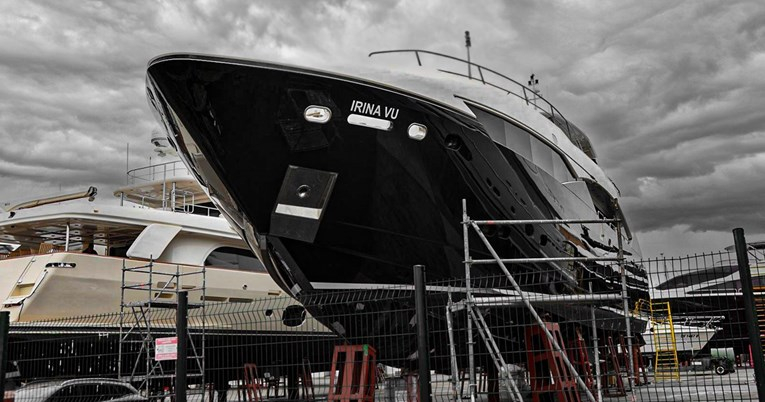TODAY’s statement by the Minister of Maritime Affairs, Transport and Infrastructure, Oleg Butković, has deepened the issue of the sailing of the Russian yacht under the sanctions of Irina VU, and not resolved it.
She had to go through police and border control in Dubrovnik
What we knew until today is that the luxury yacht Irina VU, owned by the wife of Russian oligarch Ališer Usmanov, a close friend of Russian President Vladimir Putin, was under EU, US and UK sanctions and was prohibited from sailing.
She was anchored in Betina on Murter, and according to the information from the website, she sailed from the Betina marina on October 6 at 10:14, and on October 9 around 12:00, she was in the Turkish port of Didim. In order for the yacht to leave Croatian territorial waters, it had to go through police and border control and control by the Port Authority in Dubrovnik.
Let’s also recall the words of Frano Matušić at the beginning of the text, that is, on July 13, a decision was made to freeze the yacht. How did something like that get around the police? I guess that should be more important than the remark of one employee of the port master’s office to other port masters’ offices.
After all, what about the employees of the marina and shipyard on Murter? How did they not see that there was no yacht that was under sanctions and how was no one informed about it for three months? Furthermore, the people in charge at the marina and the boathouse had to give permission because a yacht that is in dry dock cannot be launched just like that.
To put such a vessel into operation, as we have learned from unofficial conversations with port and marina employees, a crane must be raised, the ship lowered into the sea according to someone’s request, the crew must be notified. So, you need to do some paperwork, do all those actions that precede her sailing.
How did the crew know the surveillance system didn’t see the blockage?
All the entities mentioned in this text were contacted by Index, looking for answers, which apparently are still not available to the public. We did not receive answers to written inquiries, and phone calls, as usually happens on Fridays in state institutions and companies, did not bear fruit. We were only answered by SOA, writing that they cannot comment on this case.
The most important questions are the ones we asked Butković’s ministry. We were interested in who was supervising the yacht in the Betina skver (we asked the skver himself), but also who issued the order to lower the yacht into the sea, as well as whether permission was issued for it to set sail.
We asked this ministry, as well as the MUP and the Dubrovnik police, how the ship passed the border control in Dubrovnik. Finally, we were also interested in how the crew knew that the surveillance system did not see the blockage that Minister Butković was talking about today.
If they had known this, some logic dictates, they would not have gone to the border control, which they obviously had to cross. We were also interested in who made up the crew and what the sealing of the vessel implies, i.e. whether it also means a mechanical ban on driving the vehicle.
Hajdaš Dončić: There is no system, no control
Another state secretary, the one in the relevant ministry of the sea, Alen Gospočić told Slobodna Dalmacija that this is pure theft, so it is unclear how it was not reported as such, which is actually the story’s context.
He also said something interesting to Slobodna Dalmacija – that they cannot have security guards in the ports and that it is an open marina, where everyone can come without any problems. “In the port of Betina, everything is open to anyone’s access. Both you and I can come there, walk along the waterfront and jump on any yacht that is moored there.
The Ministry informed the port that the yacht was blocked, the harbor master issued an instruction to the authorities that the yacht should not be accessed in any way, and the Ministry does not hire security services for 24-hour guarding of other people’s property, nor does it plan to do so, because such a system is unsustainable “, says Gospočić.
After all, Slobodna Dalmacija rightly asked itself how it is possible for the company Brodogradilište i marina, whose founder is Adut Konzalting, a company from Split, to let a ship leave without paying its bill. Especially the one that is under sanctions and is 35 meters long.
We also called the former line minister Siniša Hajdaš Dončić. “My brown yacht sails in the basement under the manhole, that’s how one could characterize the total absence of a control system in Plenković’s, sorry Luj 14 administration.
The harbor master should have been informed of the seizure and then the harbor master’s office cannot issue a navigation permit. As I said, there is no system, no control,” said Hajdaš Dončić briefly.
Former captain Obradović: I was on two sealed ships, there were armed security guards around us
We had a long talk on this topic with the former Dubrovnik sailor, long-sea captain Đorđe Obradović, who twice found himself on ships that were sealed by the port authorities. His statements actually best suggest what kind of procedure is involved in serious countries.
“Due to debts owed to suppliers of fuel and supplies, the ship I was sailing on was sealed by the port authorities in the port of Nassau in the Bahamas. We were tied to the waterfront for about a month, and the ship was guarded by two security guards armed only with pistols, who among other equipment had portable radio devices.
The ship was sealed very simply by placing a seal similar to the ones used on electricity meters in apartments on the cabinet with the ship’s master certificate and important documents.
No one was allowed to enter the ship except for the crew who were allowed to go out, but only with a port pass, while passports and seaman’s books were on board, in a sealed cabinet with other documents. From time to time, the control of the security company and the port authorities would come and tour the ship. When the company settled the debt, the port authorities unsealed the ship and allowed it to sail,” he says.
He said more about the second case.
“The second time I was on the ship was in Galveston, Texas, when the company sold the ship to another owner. The US Coast Guard took away the ship’s most important certificates and documents, and they put seals on the helm on the bridge and on the handle to start the main engine in the engine room There were security guards on the ship and next to it.
The sealing of the ship itself is a symbolic act and in some countries it can be a simple piece of paper prohibiting sailing. The actual seizure is taken care of by the authorities of the state that seizes the ship for various reasons, and in addition to the security guards who physically guard the ship, the most important thing is radar navigation surveillance, which identifies vessels, monitors their movement and takes the necessary actions, from permission to prohibition of navigation,” he said.
“The seal can be removed, but no one would dare to do that”
Was it possible to remove these fillings?
“Of course, with slightly stronger pliers, but no one would dare to do that. Not only would the security guards alert the coast guard, but the coast guard would detect even the slightest movement of the ship with radar tracking.
Another reason is that none of the crew would dare to do something like that in America, because they would be blacklisted, lose their certificates and the right to an American visa, which were then mandatory, which would mean that they would not be able to board anywhere in the world. and work as a sailor.
As soon as the new company paid all the expenses the ship had from the sale to the takeover, the certificates were returned and it was allowed to set sail,” said former captain Obradović.
We ask him how the seized Russian yacht Irina VU was able to set sail.
“It is really difficult to answer that question. A detailed investigation will show that, but considering the whole strange situation, it is possible that it was a combination of unfortunate circumstances for the Croatian authorities or a well-planned action by the shipowner with the help of someone from Croatia.
Everything was certainly well planned, but the question arises as to how they dared to take away the confiscated yacht, i.e. how did they know that the other harbor authorities were not informed about the seizure, so the Irina VU sailed from the Adriatic, even though she was spotted and tracked by radar and properly signed off before leaving Croatian waters.
If other harbor authorities, except the Šibenik one, had known that it was a seized vessel, the Irina VU would not have been able to leave the Adriatic. The Ministry of the Sea, Transport and Infrastructure must investigate everything that happened and provide answers to your questions, because this is of interest to the public, and causes astonishment among seafarers,” he added.
Former head of SOA Letica: There is probably corruption here
Former head of SOA operations, Ante Letica, said that several elements probably came together in this case.
“It is probably, I will not say about some negligence, but indolence of state bodies and organs, there is probably also corruption in this and that is why it is necessary not only that the port captains, the port authorities, the police and so on, but also the SOA , to investigate it, to see what is negligence, irresponsibility, indolence, and what is corruption. Someone will have to answer for that,” said Letica.
He pointed out that it is strange to him how the yacht got into the sea from dry mooring.
“Then the crew was there and they sailed to Dubrovnik, completed the details that needed to be done – approvals from the port authorities, refueled, and it sailed out of Croatian territorial waters. That needs to be seen and I think that the State Attorney’s Office will give the legal qualification of that act. We need to see where there is indolence, irresponsibility, negligence of state bodies, and where there is corruption, bribery and so on, and everyone should be held accountable according to their part of responsibility,” said Letica.
He expressed the hope that everyone in the decision-making chain woke up because of this case and noticed the irregularities and gaps that need to be filled. “Now those yachts are better guarded, there are supposedly sailors there all the time who take care of maritime safety, there are also security guards, and I hope that this has now been raised to a higher level,” said Letica.
Usmanov: I’m no longer married to Irina
The reaction of Alisher Usmanov’s public relations office has since arrived following the publication of this article, we’ll transmit that press release in its entirety:
“Mr. Usmanov and Irina Viner are no longer married. Furthermore, Mr. Usmanov is not the owner of the yacht Irina VU and is in no way connected with the vessel’s disappearance from the Betina marina.
Mr. Usmanov is not an “oligarch” either – a term used to refer to businessmen who have profited through ties to the state and, more specifically, to those who participated in the privatisation of Russian state assets after the collapse of the Soviet Union. None of this applies to Mr. Usmanov, who made his fortune by creating his own companies and making very successful deals and investments on the open market.”










